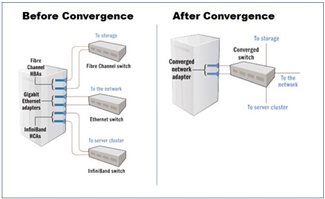Note from Lionel: Sharon collaborated with Steve Luning, Dell Fellow and VP of storage and networking architecture in the Office of the CTO for this post below.
This fall, Dell is rolling out unified fabric solutions based on 10-gigabit Ethernet. Why is the unified fabric such a big deal? Because with the higher speeds of 10-GE and follow-ons, 40- and 100-GE, Ethernet is finally fast enough to meet the combined needs of storage and server area networks.
You don’t have to look far to see proof. The Fibre Channel (FC) storage community is rethinking plans for higher speeds on FC and, instead, is adopting the Ethernet physical and data link layers for FC packet transmission. Industry standards for this are underway, including FC over Ethernet (FCoE) to encapsulate FC frames in Ethernet frames, and Data Center Bridging (DCB) to enhance Ethernet Layer 2 features to avoid packet loss.
With Ethernet as the new SAN infrastructure, it’s clear that 10GE is a big inflection point for consolidating server and storage networks into a single unified Ethernet fabric. And, a unified fabric makes it easier to move virtualized workloads around. For instance, you don’t have to think about whether a server can get to data it needs, which may be stored on an iSCSI or an FC array. Today, if the server is not equipped with two host bus adapters (HBAs) —one for iSCSI and another for FC—it may not be able to access data.
With a unified fabric, a server needs only one “converged network adapter” (CNA – Click on the image to the right to see a larger version of it) to access any data anywhere. The importance of CNAs and other converged network devices is highlighted by the Dell/Brocade announcement in September. Dell is driving CNAs that support both iSCSI and Fibre Channel over Ethernet (FCoE) as well as LAN traffic. As data centers evolve, these CNAs will become more intelligent, providing embedded switches so that virtual machines can communicate with each other in a single server more efficiently .
.
All this brings IT infrastructure closer to the future Efficient Enterprise, in which scalable pools of virtualized resources—servers, storage, and networks—are managed, provisioned, and deployed dynamically to meet application and workload requirements. And, because Ethernet is ubiquitous, it doesn’t matter whether the resources are located in the same data center or remote from one another and connected by a private Intranet or the public Internet in a “cloud computing” model.
Initially, the unified fabric will primarily benefit the server end of the data center where new Dell CNAs (in partnership with Brocade) will reduce server adapters and cables. With DCB, both FCoE and iSCSI can run simultaneously in these servers. When DCB support is deployed in core network infrastructure, FCoE can extend further and eliminate the need for FC chassis switches. iSCSI does not depend on DCB, but will benefit from it. So, with iSCSI customers can move to a unified fabric architecture with non-DCB Ethernet equipment today and then gain benefits from DCB when they upgrade their infrastructure. (See The Search for SANity: Comparing FCoE and iSCSI and FCoE versus iSCSI: SANe Security.)
We’ve come a long way and there’s plenty left to do, mainly centering on enabling virtualization in data center infrastructure, intelligently managing virtualized resources, and advancing cloud-based computing models. We see significant opportunities to help customers navigate current and upcoming technology transitions. And unifying on Ethernet is a foundation piece.